Sometimes, museums are big enough and good enough for a second tour and the National Naval Aviation Museum in Pensacola was just that museum. Well, maybe we took too much time on the awful tour that we thought we’d better take some time to actually see the place. Or, maybe it was just a great excuse for a drive. Or, finally, maybe it was a great excuse to show some more pictures of Gary when he was in the Navy. Whatever, we were on our way.
Our second trip was much more interesting and we spent time where we wanted and read what we wanted. The base is the summer home of the Blue Angels and, during the summer they give free shows - well, they are really not shows, but practices. They need to practice and, for good will, they open their practices up to all who want to come. I hear that one day in the week, they also sign autographs. Pretty neat, huh? And even I, a jaded old 68 year old will plan on being down here some time in November when we can stop in to see a Blue Angels practice. Every now and then, as we tour this area, we see them up in the sky. Actually, first we hear them and then we see them. But to see them, you’ve got to look way ahead of the sound or else you’ll miss them.
This picture is actually from the Naval Aviation web site.
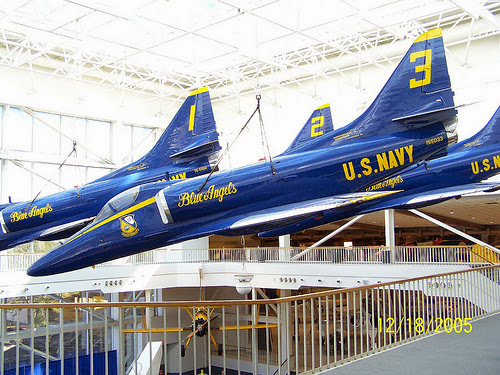
Here is a plane called the N-C which was the airplane chosen by the Navy for the first flight across the Atlantic in 1919. 3 Nancies, as the places were called, took off for the flight to Europe with a stop at the Azores. Two places went down in the Atlantic, the crew of one was picked up by a passing Greek freighter while one actually sailed to the Azores, 205 miles away. Only the N-C4 successfully completed the 15-hour flight, landed in the Azores, refueled and took off and landed in Europe. The plane was huge for the time, had three propellers and, with that canoe like fuselage, could also float.

Most of the early places were only cloth stretched over struts. Here you can see where the pinking shears cut the cloth to fit. I was surprised to find out the Lindbergh flew a cloth plane over the Atlantic. Only the engine housing was metal. Because the plane is silver, I had always assumed it was meta. Nope, cloth.
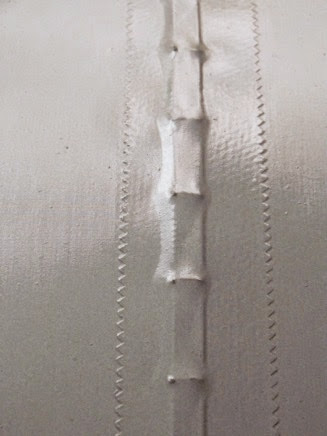
They had a neat model of the Saratoga, the carrier that Gary was on in the Navy. I remember ‘sneaking’ onto Quonset Point, the Naval base in RI, to meet the Saratoga when it docked from its Mediterranean cruise. I parked my car about 1/2 mile away from the check point, hitch-hiked with a Navy guy through the checkpoint, and he dropped me off at the pier where I waited with all the families until 2 am when the Saratoga landed. Screams, shouts, tears, it was lots of fun and I really surprised Gary. Of course, who would suspect an upright young teacher like me to ‘sneak’ onto the base? I probably could have been arrested. Never occurred to me although I knew I had to ‘sneak’ onto the base - since I wasn’t related, I was only the girlfriend.
We heard that the Saratoga had recently been shipped to Narragansett in Rhode Island where it was to be retrofitted to be a museum. Did we ever get excited about seeing it when we got to Rhode Island. However, we read here in the Naval Aviation museum that no one had the money to make the necessary adjustments and it was sold for 1 penny to a salvage yard in Texas. It was at that very moment sailing its last voyage to Texas for scrap. Shucks.
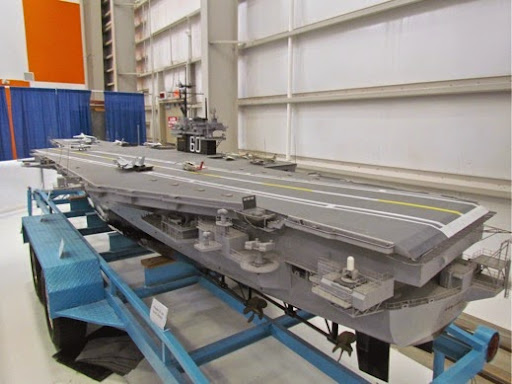
Which brings me to Gary’s Navy career. He graduated from college and planned to go on for his master’s degree - but college deferments had been tossed and, knowing that he would be drafted, volunteered for the Navy. Of course, his father had been in the Navy and so was my father, coincidentally. And, here are Lug and Ferg.

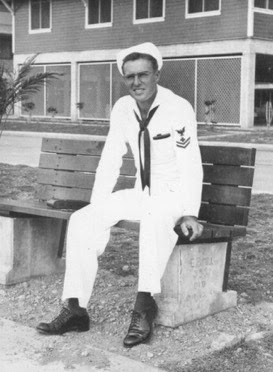
But here’s Gary with his sultry bedroom eyes standing on his parents front stoop. But my favorite picture is Gary with his sister Dawn, on the right and one of her friends.
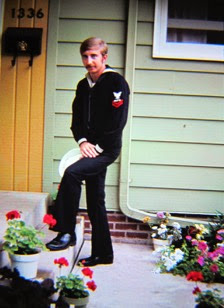
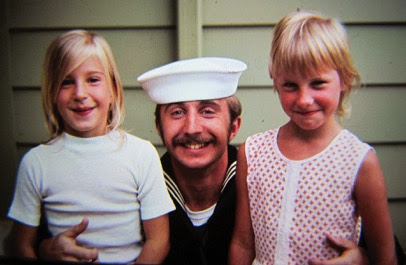
It wasn’t all work in the Navy. And here’s Gary with a wig and a guitar.
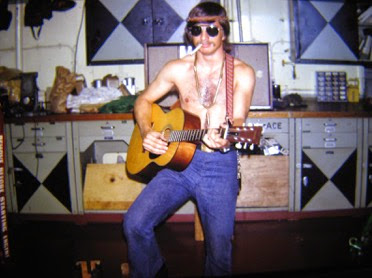
We saw the lunar module and on a TV behind it was a film of Kennedy giving his first speech about it at Rice University in September of 1962. He is proposing that America go to the moon and explaining why it is a worthy goal for a great nation.
‘We choose to go to the moon. We choose to go to the moon in this decade and do the other things, not because they are easy, but because they are hard, because that goal will serve to organize and measure the best of our energies and skills, because that challenge is one that we are willing to accept, one we are unwilling to postpone, and one which we intend to win, and the others, too.’
As I thought about that speech, I wondered if we could do that today, if we would have the will to take on such a great challenge. We can’t even feed all our children today, we can’t even get a road built, we can’t build ports large enough for the world’s ships, we can’t build new infrastructure. Build things, heck, we can’t even repair our infrastructure. Sometimes I wonder about the America that used to build and do great things. What happened to the America that built huge dams, that built the Interstate highway system, that built the Verranzano Bridge and the other bridges that span our great rivers? Sometimes, as we travel in our RV over one of those bridges, we laugh nervously, and ask each other where on the list of needed bridge repairs this particular bridge would fit. Is it ‘functionally obsolete’? Is it ‘structurally deficient’? Is it as good as the Interstate 35 bridge in Minneapolis? Then we try to distract ourselves and drive on. But there’s always another bridge ahead.
Leaving all that aside, we also wanted to tour the nearby fort built after the War of 1812, Fort Barancas, which was also on the base. I asked one of the volunteers at the Aviation Museum for a map and he told me that I didn’t need one that it was: left at the first light, right at the second and there it was. But, I insisted on a map and, when he pointed out where was leading me, it was nowhere near Fort Barancas, which was actually right across the street from the Museum. With map in hand, we set off across the base, 1/2 mile to the fort.
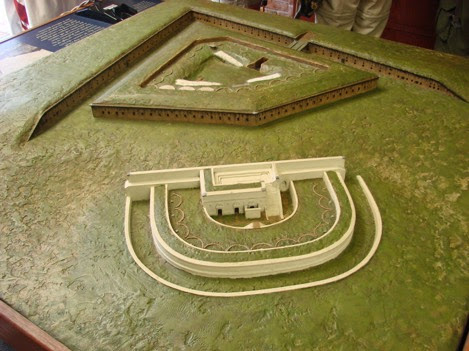
Above is the diorama in the Visitor Center. The fort is the diamond-shaped section and you can walk all the way around the inside of it through a long hallway called a scarp (pictured below). Each alcove in the scarp gallery had gun slots pointing out towards the ditch. You can also walk inside of the V-shaped section, called the counter scarp, around two sides of the fort. This also had alcoves with gun slots pointing towards the ditch. Now the only way to attack it from land was to go over the top of the V-shaped section, into the ditch, the dry moat between the gun batteries in the scarp gallery and the gun batteries in the counter scarp. Any attacking army that got into this ditch would suffer heavy casualties from the muskets and cannons pointed at them. They didn’t have a chance. Pretty impregnable. The white section was the gun emplacements facing the water.
Here is one of the arms of the gallery that we walked through. Neat to see the sun shining through the slits for the guns in each alcove.
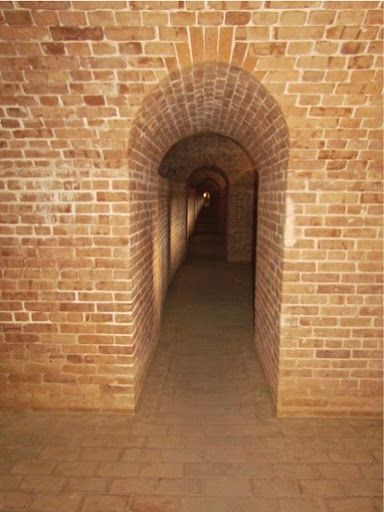
Originally the fort was built in 1698 by the Spanish who wanted to protect their holdings in the Gulf from the British and the French. The French captured Pensacola and destroyed the fort in 1719. Then the French lost to the British in 1763 and the British took it over and rebuilt another fort. Then, during the American Revolution, while the British were otherwise engaged, the Spanish recaptured it and built the water battery (white in the diorama). Finally General Andrew Jackson of the US seized the fort from the Spanish in 1814 and, when the Navy chose Pensacola Bay as the site for a Naval Ship yard, the US made improvements to the water battery and built this fort over the Spanish Fort. We also built two more forts around this bay to guard the entry from several points.
During the Civil War, Confederate troops from Alabama and Florida held this fort but the Union forces held the two other forts, Fort Pickens and Fort McRee, on each side of the water route into the bay and could prevent any ships from entering. The Confederates and the Union lobbed shells at each other for a while to no avail but finally the Union bombarded the Fort so heavily that the Confederates abandoned it in 1862 and the area saw no further action.
Finally in 1947, the fort was deemed surplus and the National Park Service took it over in 1971, completing repairs to the fort in 1980 and opening it to the public. An excellent example of the type of forts that surrounded the coast of the US and protected us from enemy incursions. On the other hand, this type of fort had a short life span since armaments improved so much during the Civil War. Stronger, rifled cannon and ironclad ships developed during the Civil War made masonry forts like Fort Barrancas outmoded.
We arrived at the fort about 3:00 and were the only two visitors for about 1/2 hour. Several other families came then but, we seemed to be the only ones who were really interested and asking questions, so we got the whole tour. The Ranger even opened several doors for us to see things that other tourists don’t usually see. That was fun. Finally, at 4:45, we left, walked back to our car and headed on back to the RV.

No comments:
Post a Comment